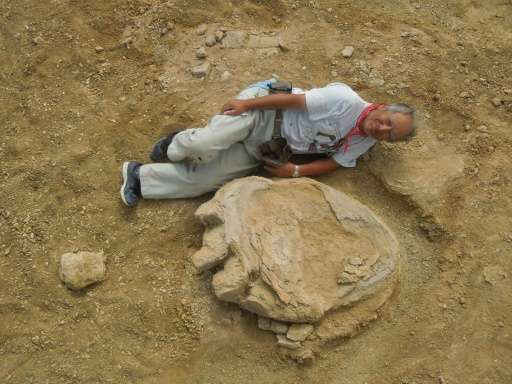New Fossil Discovery: Rare Giant Dinosaur Footprint Found In Mongolia Desert

In a photo, a grown man lays next to a giant formation dug from the ground. The object, scientists say, is a 42-inch-long dinosaur footprint. It’s so large that it’s a bit bigger than the man’s torso.
Scientists announced the discovery of the dinosaur footprint —naturally cast by sand after the giant creature stomped by during muddier times in the Mongolian Gobi desert — Friday, speculating that it likely came from a Titanosaur. That dinosaur is a long-necked beast that could have been as many as 90 feet long and 60 feet tall. The fossil was formed between 70 million and 90 million years ago, researchers said.
“This is a very rare discovery as it's a well-preserved fossil footprint that is more than a metre long with imprints of its claws, ” a statement from Okayama University of Science said.
The giant footprint joins the growing body of fossils humans have found that provide clues into the life and behavior of the creatures that came before man and roamed the Earth millions upon millions of years ago.
As it turns out, a Titanosaur fossil is considered to be the largest dinosaur discovery ever. A casting of its bones is currently on display in the American Museum of Natural History in New York City, where the beast’s giant neck extends out of its display room and through a doorway. The dinosaur’s actual bones are much too heavy to display on their own, researchers have said. Still, some of the original fossils are on display on adjacent walls.
To put the size of those dinosaurs in perspective, they’re longer than Jumbo Jets and weighed about 70 tons when they walked the Earth. That’s nearly double the maximum weight of an American 18-wheel semi-truck.
But that fossil in New York may not be the biggest dinosaur we eventually find. Researchers note that we continually find bigger and bigger specimen and, although they say they think we’re getting close to the biggest ones we’re going to discover, another find may be out there waiting.
© Copyright IBTimes 2024. All rights reserved.






















